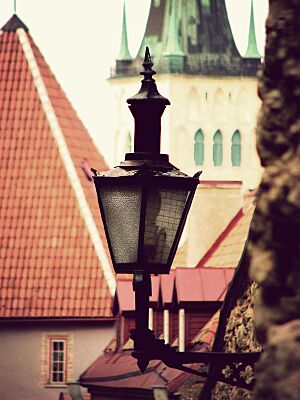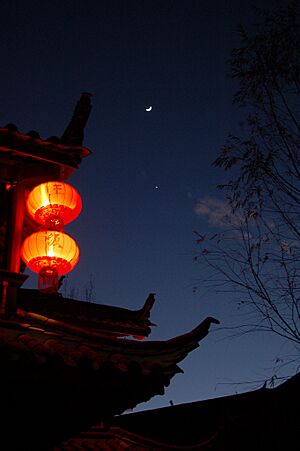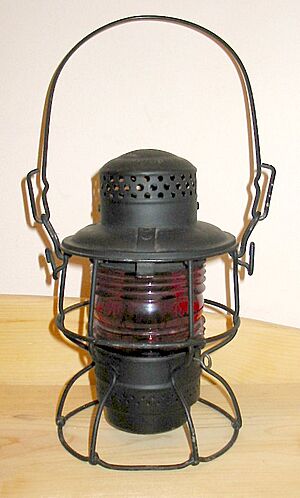Lantern facts for kids
A lantern is a special light that you can carry around. It's used to light up dark places, whether you're inside or outside. People use lanterns for many things, like giving signals or lighting up a camping trip.
Some lanterns hold candles, while others use fuel like alcohol or kerosene to make light. Lanterns that give off a soft glow are often used as decorations. You can also see lanterns at many festivals, like the Obon festival in Japan.
Contents
Lanterns Through History

The word "lantern" comes from an old French word, which came from a Latin word. It might even have come from an ancient Greek word.
People have used lanterns for a very long time, since ancient times. They were used to provide light, not just for decoration. Some early lanterns used a wick in oil. Others were simply holders to protect a candle. Before glass was common, people used thin, flat pieces of animal horn as the clear window for their lanterns.
Lanterns come in many different designs. Some hang from buildings, while others sit on the ground. Paper lanterns are popular in many cultures around the world. Today, many decorative lanterns use an electric light inside a fancy glass case.
Long ago, in ancient China, people sometimes caught fireflies. They put them in clear containers and used them as temporary lanterns. Lanterns are a big part of many Asian festivals. For example, during the Ghost Festival, people float lotus-shaped lanterns on rivers and seas. This is a way to guide the spirits of ancestors.
During the Lantern Festival, many lanterns are displayed on the 15th day of the first lunar month in China. You can also see kongming lanterns floating high into the sky during Chinese celebrations. The Seoul Lantern Festival also features lanterns as its main theme.
In ancient India, people also used fireflies in clear containers. But because these lights didn't last long, people often used fire torches more.
In the Eastern Orthodox Church, lanterns are used in religious parades. They usually go in front of the cross during special church services. Lanterns are also used to carry the Holy Fire from the Church of the Holy Sepulchre. This happens on Great Saturday during Holy Week.
Modern Fuel Lanterns
Fuel-powered lanterns can be a bit risky. This is because you are handling flammable fuels. There is also a risk of fire or burns from the heat. If used indoors, they can produce carbon monoxide poisoning, which is very dangerous. Always use them in well-ventilated areas.
Simple wick lanterns are still available today. They are inexpensive and strong. However, they don't give off much light and are not good for reading. You need to trim the wick often and clean soot from the glass chimney.
Mantle lanterns use a special ceramic fabric called a gas mantle. This mantle glows brightly when heated by a flame. The mantle itself doesn't burn. The heat can come from gas, kerosene, or a liquid fuel like "white gas" (which is like naphtha). A glass shield, called a globe or chimney, goes around the mantle. This protects it from high temperatures and helps the air flow.
Some lanterns use "white gas," also known as Coleman fuel. These are pumped by hand to create pressure. The Coleman Company makes them in one or two-mantle styles. Some models can even use gasoline.
Today, many people are choosing battery-powered fluorescent lamp and LED lanterns. These are safer for young people and for use inside tents. Many companies, including Coleman, make battery-operated lanterns. Liquid fuel lanterns are still popular where their fuel is easy to get.
Many portable mantle-type lanterns now use compressed fuel gases. These include propane, or a mix of propane and butane. These lamps usually use a small, disposable steel container for the fuel. This makes refueling safer because you don't handle liquid fuel. Also, extra fuel containers can last a very long time if kept dry and cool.
Modern Electric Lanterns
Fixed Lighting
Some lanterns are designed to be permanent electric lights. You can find them inside buildings, in gardens, and in city lighting. Their styles can remind us of old times. They can also match other street items or just look nice. These lanterns are made to work with different wired power supplies.
Some rechargeable fluorescent lanterns can stay plugged in all the time. They can even turn on automatically if the power goes out. This is very helpful in some situations. If the power is out for a long time, or if you are in a remote area, you can recharge them. You can use a car's 12-volt system or a small solar-powered charger. Solar-powered lanterns are now popular in developing countries. They offer a safer and cheaper choice than kerosene lamps.
Battery-Powered Lanterns
Many different battery types are used in portable lights. They are more convenient, safer, and produce less heat than lanterns that burn fuel.
LED Lanterns
Lanterns that use LEDs are very popular. They use less energy and are tougher than other types. Also, the cost of LEDs for lighting has gone down a lot.
Gallery
Related pages
Images for kids
-
Tin lantern, candle for light, with horn windows (Minnesota, USA, c. 1863)
-
High-end LED lantern, powered by lithium-ion batteries, with modern features like a USB-C charging port and variable color temperature (2020)
-
Lantern in Wuppertal, Germany
See also
 In Spanish: Farol (iluminación) para niños
In Spanish: Farol (iluminación) para niños

















